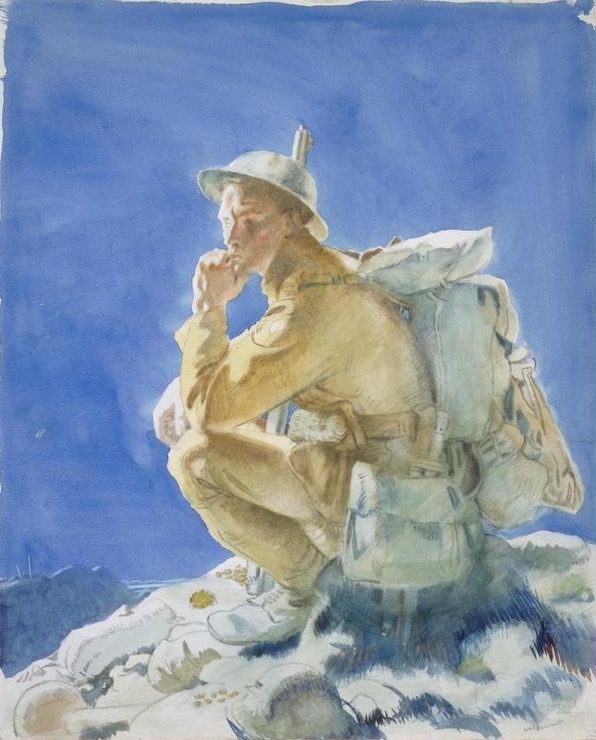registerfasterusing
These lil nigga
- Joined
- Oct 12, 2024
- Posts
- 20,724
- Reputation
- 34,836
The rain gradually abated and 17 October began fair but clouded over and rain fell again during the night. The British bombardment had continued as planned but the German artillery reply was vigorous leading up to zero hour at 3:40 a.m. on 18 October.
On most of the brigade fronts, assembly positions had been marked with white tape and compass bearings taken of the direction to the objectives but at zero hour, the British positions were flooded. The moon was obscured by low clouds, troops slipped and fell in the mud and weapons were clogged, leaving only hand grenades and bayonets with which to fight. On the right the 4th Division attacked with the 11th Brigade to take Frosty, Hazy, Rainy and Dewdrop trenches, while in the French sector the attack began at 11:45 a.m. Groups of the 1st Rifle Brigade reached the gun-pits before Hazy Trench and were forced back, the 1st East Lancs were forced under cover in front of Dewdrop Trench, by the fire of hidden machine-guns. The 1st King's Own of the 12th Brigade and the German defenders mutually attacked and counter-attacked around Spectrum Trench and then the King's Own bombed along Spectrum for 70 yd (64 m) towards Dewdrop Trench. In the 6th Division, the 9th Norfolk attacked Mild and Cloudy trenches but was bombarded before zero hour and moved so slowly through mud that it lost the barrage. The battalion captured the north-west end of Mild Trench and then repulsed a counter-attack as dark fell. (After dark on 19 October, a platoon of the 1st Somerset Light Infantry found Frosty Trench unoccupied and defeated a counter-attack.)
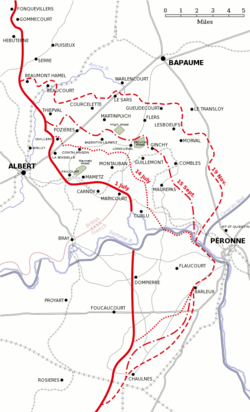
Map showing the Anglo-French front line on 19 November.
The XV Corps made flank attacks because the centre faced a dip either side of the Flers–Thilloy road. The 12th (Eastern) Division on the right attacked Grease Trench with the 2nd Hampshire and 4th Worcester battalions and the south-east end of Bayonet Trench with the 9th Essex battalion from the 35th Brigade. The 2nd Hampshire and the 4th Worcester took Grease Trench with few losses but then had many casualties trying to press on. The Worcester blocked Hilt Trench on the left after the 9th Essex were not able to advance, except for one company which got into Bayonet Trench and was then bombed out by counter-attacks from the flanks. On the left of the 30th Division the 2nd Green Howards almost reached the west end of Bayonet Trench before being stopped by showers of hand-grenades. Parties bombed up part of Bite Trench but reinforcements were stopped from moving up by the mud. On the left the 18th King's and 2nd Wiltshire attacked the Gird lines and found uncut wire on the right and enfiladed from the left, most of the 2nd Wiltshire being killed.
Two tanks had been brought up to Flers in case the night attacks failed and during a lull at 8:00 a.m. one bogged in mud and the other drove to the end of Gird Trench and machine-gunned it for twenty minutes, killing many Germans who ran back to the north-east. The commander signalled the infantry to move up but the infantry were so disorganised and exhausted that none moved. The tank drove along Gird Trench to the Le Barque road and then returned. III Corps attacked Snag Trench again as smoke and lachrymatory bombs were fired from the 15th (Scottish) Division front to try to suppress German fire from the butte and from Warlencourt village. The 5th Cameron Highlanders, on the right of the 9th (Scottish) Division, took a trench from the Le Barque road to 200 yd (180 m) from the Nose (the junction of Snag Trench and the Tail) and met some of the 2nd Wiltshire.
A German counter-attack on the right got a footing in the trench, until another attack after dark drove them back and on the left two companies of the 1st South African Regiment overran Snag Trench, pressed on and were shot down by machine-gun fire from the butte, apart from a small group who got into Snag Trench next to the Cameron. At dawn the South Africans tried to bomb along Snag from the Pimple and at 5:45 p.m. attacked from both flanks. The South Africans managed to advance, leaving the Germans occupying only 100 yd (91 m) of the trench around the Nose as night fell. The rain continued during 19 October; at dawn, German parties accompanied by a Flammenwerfer detachment advanced along the Tail to attack eastwards along Snag Trench. The South Africans retreated towards the 8th Black Watch which had relieved the Cameron as a counter-attack on the right flank was repulsed. British artillery maintained the bombardment on the Nose and Tail areas but the South African Brigade was too exhausted to attack again and after dark the 27th Brigade took over all the 9th (Scottish) Division front, struggling through mud and water. The 6th King’s Own Scottish Borderers (KOSB) was considered fit to attack at 4:00 p.m. on 20 October and in confused fighting, captured, lost and retook the Nose. By dark the 6th KOSB had control of Snag Trench and some Royal Scots had advanced along 250 yd (230 m) of the Tail.
The rest of the Saillisels had been held and the German hold on St Pierre Vaast wood stopped the French from rolling up the German defences from north to south. The 4th Division took prisoners from Bavarian Infantry Regiment 15 of the 2nd Bavarian Division and the II Battalion, Bavarian Infantry Regiment 15 suffered 50 per cent casualties. Most of Reserve Infantry Regiment 92 was captured and Infantry Regiment 64 of the 6th Division lost 200 men of the I Battalion. Infantry Regiment 181 of the 40th Division found that the mud reduced the effect of the British bombardment and the infantry were unable to make a quick advance. Prisoners were taken from I and II battalions, Infantry Regiment 104 at Snag Trench and the III Battalion conducted a counter-attack. On 19 October, the storm detachment of the 40th Division counter-attacked in two columns with flame-throwers, a machine-gun section and the best men of I Battalion, Infantry Regiment 104; the advance of the left column was halted by one of the flame-throwers exploding. Most of the survivors of Infantry Regiment 104 were relieved by III Battalion, Infantry Regiment 134. The trenches of Infantry Regiment 104 were smashed by artillery-fire and the troops were withdrawn, according to the new policy, of avoiding pointless casualties by abandoning outposts of no tactical value.
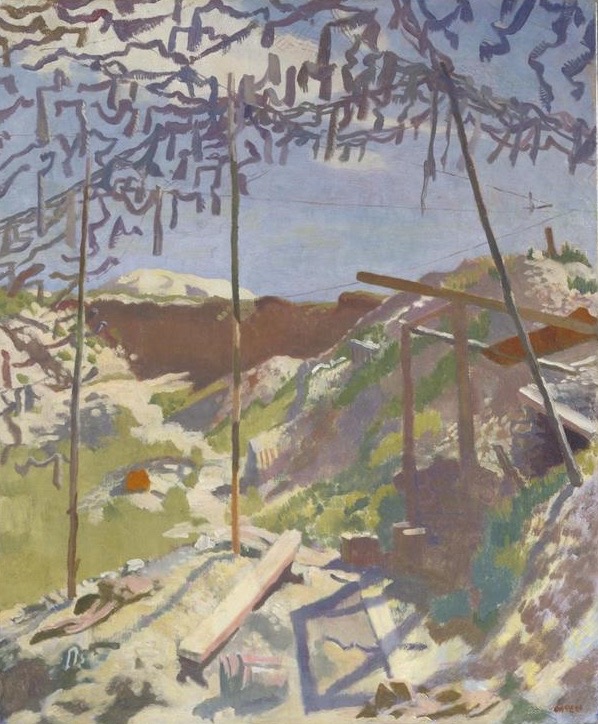
William Orpen: A German Gunners Shelter, Warlencourt
TLDR:
On 17 October, as two companies of Infantry Regiment 104 counter-attacked, they were confronted by a "gigantic iron dragon" (a tank) which fired on German positions with machine-guns and light guns. Most of the 9th Company was annihilated before the tank retired. The capture of the Butte by the 9th (Scottish) Division was postponed and Snag Trench was made the objective of an attack at 3:40 a.m. on 18 October. On the right flank an attack was to be made by the 30th Division. The 26th Brigade was to attack with a battalion in line, the four companies moving on platoon fronts with a supporting company and a machine-gun company; Stokes mortars were to add to the bombardment of the German front line. On the left flank, the South African Brigade was to attack with the 1st Regiment, with three companies in line, also on platoon fronts, one company in support and one in reserve. The weather broke again and the attack took place in a deluge.
On the right, the battalion advanced close to the creeping barrage and rushed Snag Trench as the standing barrage lifted; the garrison ran back to the Gird trenches. A counter-attack began after fifteen minutes, bombed back into the trench on the right and was repulsed soon after. On the left, the South African left flank was repulsed and contact was lost with the right flank units until 9:30 a.m., when a Lewis gun crew made contact with the 26th Brigade battalion, which had also met troops of the 30th Division. In the afternoon, a party of German troops were seen massing for a counter-attack and were dispersed by artillery and small arms fire. At 5:30 p.m. a counter-attack on the left was also repulsed. During the night a British pioneer company arrived and dug a communication trench back to the old front line.
The Lewis gun team was the only South African party to reach the objective; the centre and right-hand companies disappeared, apart from the Lewis gunners and a few wounded. It was thought that the South Africans overran Snag Trench, which was unrecognisable and were cut down by the machine-guns at the Butte; a few stragglers returned later in the day with 19 prisoners. The left flank company was stopped by uncut wire and then caught by machine-gun fire, which inflicted many casualties; the remaining troops retired to the British front line. Furse ordered another attack for 5:45 p.m. and for the main German strong point the Nose to be bombarded, before the South Africans captured it and formed a trench block 500 yd (460 m) up Tail Trench. The rainstorm had turned the ground into a sea of mud so deep that moving 1,000 yd (910 m) took four hours. A company was to attack from the Pimple and another was to get into Snag Trench east of the Nose and attack westwards. The attack from the Pimple entered a hollow, full of German machine-gun nests which stopped the advance. The South African party got into Snag Trench and advanced to within 25 yd (23 m) of the Nose and were then repulsed by the fire of three machine-guns, reoccupying Snag Trench a few hours later.
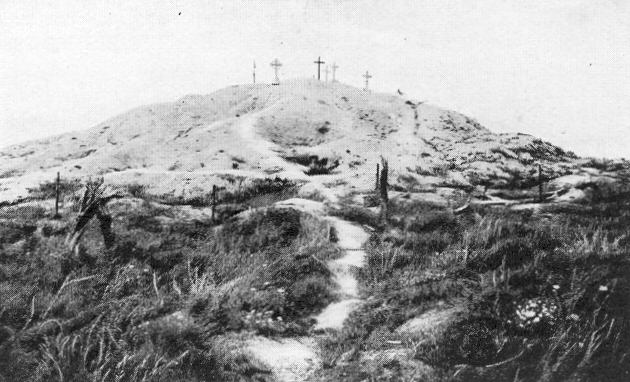
Photograph of the Butte de Warlencourt, 1916
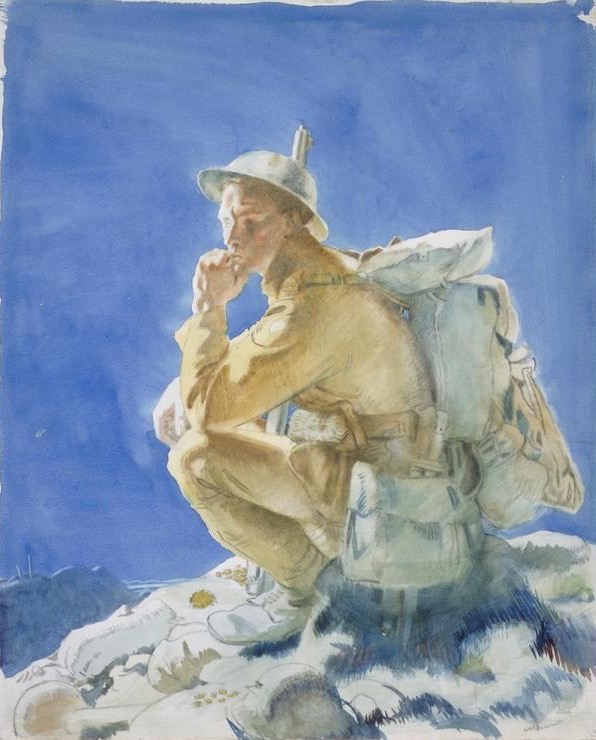
William Orpen: The Thinker on the Butte de Warlencourt
On most of the brigade fronts, assembly positions had been marked with white tape and compass bearings taken of the direction to the objectives but at zero hour, the British positions were flooded. The moon was obscured by low clouds, troops slipped and fell in the mud and weapons were clogged, leaving only hand grenades and bayonets with which to fight. On the right the 4th Division attacked with the 11th Brigade to take Frosty, Hazy, Rainy and Dewdrop trenches, while in the French sector the attack began at 11:45 a.m. Groups of the 1st Rifle Brigade reached the gun-pits before Hazy Trench and were forced back, the 1st East Lancs were forced under cover in front of Dewdrop Trench, by the fire of hidden machine-guns. The 1st King's Own of the 12th Brigade and the German defenders mutually attacked and counter-attacked around Spectrum Trench and then the King's Own bombed along Spectrum for 70 yd (64 m) towards Dewdrop Trench. In the 6th Division, the 9th Norfolk attacked Mild and Cloudy trenches but was bombarded before zero hour and moved so slowly through mud that it lost the barrage. The battalion captured the north-west end of Mild Trench and then repulsed a counter-attack as dark fell. (After dark on 19 October, a platoon of the 1st Somerset Light Infantry found Frosty Trench unoccupied and defeated a counter-attack.)

Map showing the Anglo-French front line on 19 November.
The XV Corps made flank attacks because the centre faced a dip either side of the Flers–Thilloy road. The 12th (Eastern) Division on the right attacked Grease Trench with the 2nd Hampshire and 4th Worcester battalions and the south-east end of Bayonet Trench with the 9th Essex battalion from the 35th Brigade. The 2nd Hampshire and the 4th Worcester took Grease Trench with few losses but then had many casualties trying to press on. The Worcester blocked Hilt Trench on the left after the 9th Essex were not able to advance, except for one company which got into Bayonet Trench and was then bombed out by counter-attacks from the flanks. On the left of the 30th Division the 2nd Green Howards almost reached the west end of Bayonet Trench before being stopped by showers of hand-grenades. Parties bombed up part of Bite Trench but reinforcements were stopped from moving up by the mud. On the left the 18th King's and 2nd Wiltshire attacked the Gird lines and found uncut wire on the right and enfiladed from the left, most of the 2nd Wiltshire being killed.
Two tanks had been brought up to Flers in case the night attacks failed and during a lull at 8:00 a.m. one bogged in mud and the other drove to the end of Gird Trench and machine-gunned it for twenty minutes, killing many Germans who ran back to the north-east. The commander signalled the infantry to move up but the infantry were so disorganised and exhausted that none moved. The tank drove along Gird Trench to the Le Barque road and then returned. III Corps attacked Snag Trench again as smoke and lachrymatory bombs were fired from the 15th (Scottish) Division front to try to suppress German fire from the butte and from Warlencourt village. The 5th Cameron Highlanders, on the right of the 9th (Scottish) Division, took a trench from the Le Barque road to 200 yd (180 m) from the Nose (the junction of Snag Trench and the Tail) and met some of the 2nd Wiltshire.
A German counter-attack on the right got a footing in the trench, until another attack after dark drove them back and on the left two companies of the 1st South African Regiment overran Snag Trench, pressed on and were shot down by machine-gun fire from the butte, apart from a small group who got into Snag Trench next to the Cameron. At dawn the South Africans tried to bomb along Snag from the Pimple and at 5:45 p.m. attacked from both flanks. The South Africans managed to advance, leaving the Germans occupying only 100 yd (91 m) of the trench around the Nose as night fell. The rain continued during 19 October; at dawn, German parties accompanied by a Flammenwerfer detachment advanced along the Tail to attack eastwards along Snag Trench. The South Africans retreated towards the 8th Black Watch which had relieved the Cameron as a counter-attack on the right flank was repulsed. British artillery maintained the bombardment on the Nose and Tail areas but the South African Brigade was too exhausted to attack again and after dark the 27th Brigade took over all the 9th (Scottish) Division front, struggling through mud and water. The 6th King’s Own Scottish Borderers (KOSB) was considered fit to attack at 4:00 p.m. on 20 October and in confused fighting, captured, lost and retook the Nose. By dark the 6th KOSB had control of Snag Trench and some Royal Scots had advanced along 250 yd (230 m) of the Tail.
The rest of the Saillisels had been held and the German hold on St Pierre Vaast wood stopped the French from rolling up the German defences from north to south. The 4th Division took prisoners from Bavarian Infantry Regiment 15 of the 2nd Bavarian Division and the II Battalion, Bavarian Infantry Regiment 15 suffered 50 per cent casualties. Most of Reserve Infantry Regiment 92 was captured and Infantry Regiment 64 of the 6th Division lost 200 men of the I Battalion. Infantry Regiment 181 of the 40th Division found that the mud reduced the effect of the British bombardment and the infantry were unable to make a quick advance. Prisoners were taken from I and II battalions, Infantry Regiment 104 at Snag Trench and the III Battalion conducted a counter-attack. On 19 October, the storm detachment of the 40th Division counter-attacked in two columns with flame-throwers, a machine-gun section and the best men of I Battalion, Infantry Regiment 104; the advance of the left column was halted by one of the flame-throwers exploding. Most of the survivors of Infantry Regiment 104 were relieved by III Battalion, Infantry Regiment 134. The trenches of Infantry Regiment 104 were smashed by artillery-fire and the troops were withdrawn, according to the new policy, of avoiding pointless casualties by abandoning outposts of no tactical value.

William Orpen: A German Gunners Shelter, Warlencourt
TLDR:
On 17 October, as two companies of Infantry Regiment 104 counter-attacked, they were confronted by a "gigantic iron dragon" (a tank) which fired on German positions with machine-guns and light guns. Most of the 9th Company was annihilated before the tank retired. The capture of the Butte by the 9th (Scottish) Division was postponed and Snag Trench was made the objective of an attack at 3:40 a.m. on 18 October. On the right flank an attack was to be made by the 30th Division. The 26th Brigade was to attack with a battalion in line, the four companies moving on platoon fronts with a supporting company and a machine-gun company; Stokes mortars were to add to the bombardment of the German front line. On the left flank, the South African Brigade was to attack with the 1st Regiment, with three companies in line, also on platoon fronts, one company in support and one in reserve. The weather broke again and the attack took place in a deluge.
On the right, the battalion advanced close to the creeping barrage and rushed Snag Trench as the standing barrage lifted; the garrison ran back to the Gird trenches. A counter-attack began after fifteen minutes, bombed back into the trench on the right and was repulsed soon after. On the left, the South African left flank was repulsed and contact was lost with the right flank units until 9:30 a.m., when a Lewis gun crew made contact with the 26th Brigade battalion, which had also met troops of the 30th Division. In the afternoon, a party of German troops were seen massing for a counter-attack and were dispersed by artillery and small arms fire. At 5:30 p.m. a counter-attack on the left was also repulsed. During the night a British pioneer company arrived and dug a communication trench back to the old front line.
The Lewis gun team was the only South African party to reach the objective; the centre and right-hand companies disappeared, apart from the Lewis gunners and a few wounded. It was thought that the South Africans overran Snag Trench, which was unrecognisable and were cut down by the machine-guns at the Butte; a few stragglers returned later in the day with 19 prisoners. The left flank company was stopped by uncut wire and then caught by machine-gun fire, which inflicted many casualties; the remaining troops retired to the British front line. Furse ordered another attack for 5:45 p.m. and for the main German strong point the Nose to be bombarded, before the South Africans captured it and formed a trench block 500 yd (460 m) up Tail Trench. The rainstorm had turned the ground into a sea of mud so deep that moving 1,000 yd (910 m) took four hours. A company was to attack from the Pimple and another was to get into Snag Trench east of the Nose and attack westwards. The attack from the Pimple entered a hollow, full of German machine-gun nests which stopped the advance. The South African party got into Snag Trench and advanced to within 25 yd (23 m) of the Nose and were then repulsed by the fire of three machine-guns, reoccupying Snag Trench a few hours later.

Photograph of the Butte de Warlencourt, 1916

William Orpen: The Thinker on the Butte de Warlencourt
Last edited:


